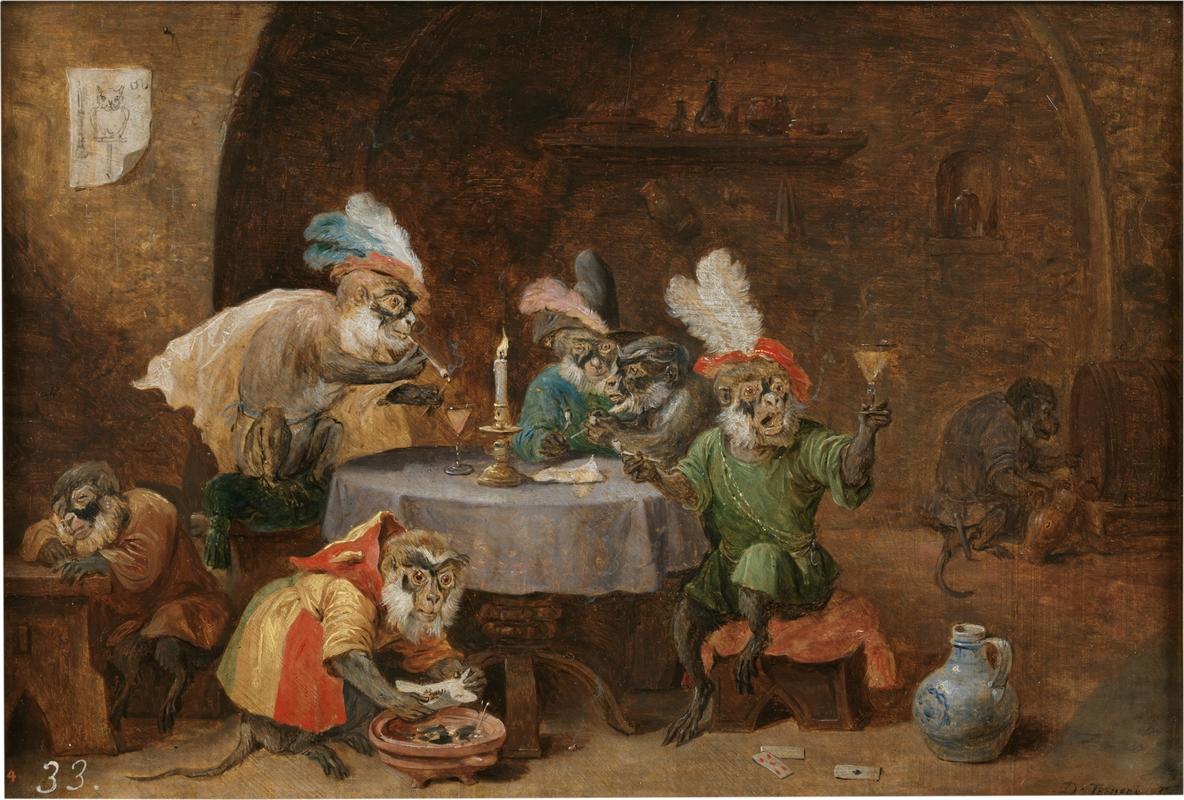More about Monkeys Smoking and Drinking

Sr. Contributor
Three monkeys walk into a tavern…
No, but seriously, folks, depicting monkeys acting and dressing like humans is a thing, or was a thing anyway, back when David Teniers the Younger painted Monkeys Smoking and Drinking, around 1660. This type of painting genre is called singerie, which means “monkey trick” or “monkey game” in French, and can be traced back to early Egypt, but became popular in the 16th century.
Monkeys take on a human role in these paintings, sometimes (but not always) wearing human clothes and hats; they have been depicted playing backgammon, painting, sculpting, working as barbers (with cats as their customers), and much more, including eating (like humans), drinking, and smoking, like the ones in Teniers’ work here. There’s more than a few of these paintings that feature the monkeys interacting with cats for some reason. In addition to the barber monkeys, there’s a monkey doctor examining a cat, monkey musicians with cat singers, monkey troops with a cat prisoner, and more.
The monkeys were often used to mock human behavior and social situations, sometimes even specific people. Tavern scenes with humans were a favorite subject; they could be busy, like Adriaen Brouwer’s aptly titled Interior of a Tavern, or bawdy, like Gerard van Honthorst’s Merry Company, where there’s drinking going on as well as prostitutes hanging out. If there are any singerie paintings featuring prostitution out there, they must be pretty rare (that would just be weird). That being said, the monkeys have the eating, drinking, and general partying down just fine.
Even if one were to paint a tavern/bar setting today, the scene can pretty much write (paint?) itself; there can be a lot going on at any given time. You have people of all walks of life doing what they do in bars: drink, eat, smoke (maybe not so much these days), talk, sing, fight, flirt, etc. The monkeys in Teniers’ piece seem to be doing more smoking than drinking in this tavern, although one of them is calling for his glass to be filled while another fills the pitcher from a wine or ale cask.
Teniers was quite creative when it came to his singerie pieces; he painted both a monkey sculptor and painter, monkeys cooking and feasting at a banquet, monkeys playing cards (in a tavern, naturally), a monkey smoking with an owl, and others along this line. These types of paintings would have been a nice addition to any 17th century kunstkamer, which translates as “art room,” but more commonly known as a “cabinet of curiosities.” A singerie painting would have been right at home in any family’s kunstkamer, which often displayed unusual objects from foreign countries, mummified animals or animal parts, feathers, antlers, and, of course, sculptures and paintings.
Monkeys Smoking and Drinking was part of the Royal Collection in the Palace of Aranjuez, Madrid, and acquired by King Carlos the IV in 1818. Around the time this painting was done, Teniers lived and worked in Brussels as court painter for the Archduke Leopold Wilhelm. It’s possible that the painting was done for the Archduke, then later made its way to Spain, as these areas were very incestuous at the time.
Sources
- Davidson, Jane P. David Teniers the Younger. Boulder, CO: Westview Press, 1979.
- Lee, Alexander. 2020. “Monkeys Natural Histories.” History Today 10 (2): 84–88. http://0-search.ebscohost.com.pacificatclassic.pacific.edu/login.aspx?d….
- Teniers the Younger, D. (1665, January 1). Monkeys smoking and drinking - the collection. The Collection - Museo Nacional del Prado. https://www.museodelprado.es/en/the-collection/art-work/monkeys-smoking…
- “The Singerie: Monkeys Acting as Humans in Art.” The Public Domain Review. https://publicdomainreview.org/collection/the-singerie-monkeys-acting-a….
- Wheelock, Arthur K. Flemish Paintings of the Seventeenth Century. Washington, D.C.: National Gallery of Art, 2005.
- Wikimedia Foundation. (2022, June 12). Cabinet of curiosities. Wikipedia. https://en.wikipedia.org/wiki/Cabinet_of_curiosities











